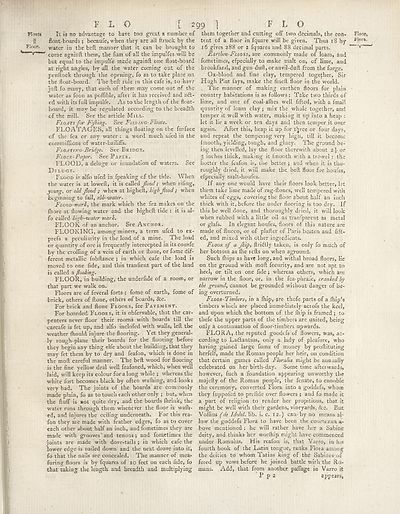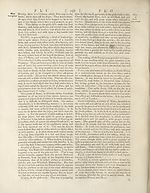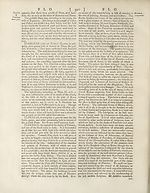Encyclopaedia Britannica > Volume 7, ETM-GOA
(325) Page 299 - FLO
Download files
Complete book:
Individual page:
Thumbnail gallery: Grid view | List view

FLO [ 299 1 F L O
Floats It is no advantage to have too great a number of
|| float-boards ; becaufe, when they are ail (truck by the
Floor- water in the beft manner that it can be brought to
come againft them, the fum of all the impulfes will be
but equal to the impulfe made againft one float-board
at right angles, by all the water coming out of the
penftock through the opening, fo as to take place on
the float-board. The beft rule in this cafe is, to have
juft fo many, that each of them may come out of the
water as foon as poffible, after it has received and a£t-
ed with its full impulfe. As to the length of the float-
board, it may be regulated according to the breadth
of the mill. See the article Mill.
Floats fur Ffhing. See Fishing-Floats.
FLOATAGES, all things floating on the furfacq
of the fea or any water : a word much ufed in the
cornmifiions of water-bailiffs.
Floating-Bridge. See Bridge.
Flock-Paper. See Paper.
FLOOD, a deluge or inundation of waters. See
Deluge.
Flood is alfo ufed in fpeaking of the tide. When
the water is at loweft, it is called flood; when riling,
young, or old flood ; when at higheft, high flood; when
beginning to fail, ebb-water.
Flood-mark, the mark which the fea makes on the
(hore at flowing water and the hightft tide : it is al¬
fo called high-water mark.
FLOOK of an anchor. See Anchor.
FLOORING, among miners, a term ufed to ex-
prefs a peculiarity in the load of a mine. The load
or quantity of ore is frequently intercepted in its courfe
by the croffing of a vein of earth or ftone, or fome dif¬
ferent metallic fubftance ; in which, cafe the load is
moved to one fide, and this tranfient part of the land
is called a Jlooking.
FLOOR, in building, the underfide of a room, or
that part we walk on.
Floors are of feveral forts ; fome of earth, fome of
brick, others of ftone, others of boards, &c.
For brick and ftone Floors, fee Pavement.
For boarded Floors, it is obfervable, that the car¬
penters never floor their rooms with boards till the
carcafe is fet up, and alfo inclofed with walls, left the
weather ftiould injure the flooring. Yet they general¬
ly rough-plane their boards for the flooring before
they begin any thing elfe about the building, that they
may fet them by to dry and feafon, which is done in
the moft careful manner. The beft wood for flooring
is the fine yellow deal well feafoned, which, when well
laid, will keep its colour for a long while ; whereas the
white fort becomes black by often wafhing, and looks
very bad. The joints of the boards are commonly
made plain, fo as to touch each other only ; but, when
the ftuff is mot quite dry, and the boards fliriuk, the
water runs through them whenever the floor is waih-
ed, and injures the ceiling underneath. Bor this rea-
fon they aie made with feather edges, fo as to cover
each other about half an inch, and fometimes they are
made with grooves' and tenons; and fometimes the
joints are made with dove-tails ; in which cafe the
lower edge is nailed down and the next drove into it,
fo that the nails are concealed. The manner of mea-
furing floors is by fquares of 10 feet on each fide, fo
that taking the length and breadth and multiplying
them together and cutting off two decimals, the coft- Floor,
tent of a floor in fquare will be given. Thus 18 by Flora.
16 gives 288 or 2 fquares and 88 decimal parts. y—
Earthen-Floors, are commonly made of loam, and
fometimes, efpecially to make malt on, of lime, and
brookfand, and gun-dull, or anvil-duft from the forge.
Ox-blood and fine clay, tempered together, Sir
Hugh Piat fays, make the fined floor in the world.
The manner of making earthen floors for plain
country habitations is as follows: Take two thirds of
lime, and one of coal-aflies well fifted, with a fmall
quantity of loam clay; mix the whole together, and
temper it well with water, making it up ipto a heap :
let it lie a week or ten days and then temper it over
again. After this, heap it up for three or four days,
and repeat the tempering very high, till it become
fmooth, yielding, tough, and gluey. The ground be¬
ing then levelled, lay the floor therewith about 2^ or
3 inches thick, making it fmooth with a trowel: the
hotter the feafon is, the better ; and when it is tho¬
roughly dried, it will make the. beft floor for houfes,
efpecially malt-houfes.
If any one would have their floors look better, let
them take lime made of rag-ftones, well tempered with
whites of eggs, covering the floor about half an inch
thick with it, before the under flooring is too dry. If
this be well done, and thoroughly dried, it will look
when rubbed with a little oil as tranfparent as metal
or glafs. In elegant houfes, floors of this nature are
made of ftucco, or of platter of Paris beaten and fift¬
ed, and mixed with other ingredients.
Floor of a Jhip, ftri&ly taken, is only fo much of
her bottom as (he refts on when aground.
Such fhips as have long, and withal broad floors, lie
on the ground with moft fecurity, and are not apt to
heel, or tilt on one fide; whereas others, which are
narrow in the floor, or, in the fea-phrafe, cranked by
the ground, cannot be grounded without danger of be¬
ing overturned.
FiooR-Timbers, in a fhip, are thofe parts of a (hip’s
timbers which are placed immediately acrofs the keel,
and upon which the bottom of the (hip is framed; to
thefe the upper parts of the timbers are united, being
only a continuation of floor-timbers upwards.
FLORA, the reputed goodtfs of flowers, was, ac¬
cording to Laftantius, only a lady of pleafure, who
having gained large fums of money by proftituting
herfelf, made the Roman people her heir, on condition
that certain games called Floralia might be annually
celebrated on her birth-day. Some time afterwards,
however, fuch a foundation appearing unworthy the
majefty of the Roman people, the fenate, to ennoble
the ceremony, converted Flora into a goddefs, whom
they fuppofed to prefide over flowers ; and fo made it
a part of religion to render her propitious, that it
might be well with their gardens, vineyards, &c. But
Voffius (de Idolol. lib. i. c. 12.) can by no means al¬
low the goddefs Flora to have been the courtezan a-
bove mentioned : he will rather have her a Sabine
deity, and thinks her worftiip might have commenced
under Romulus. His reafon is, that Varro, in his
fourth book of the Latin tongue, ranks Floia among
the deities to whom Tatius king of the Sabines of
fered up vows before he joined battle with the Ro¬
mans. Add, that from another paffage in Varro it
P p 2 appears,
Floats It is no advantage to have too great a number of
|| float-boards ; becaufe, when they are ail (truck by the
Floor- water in the beft manner that it can be brought to
come againft them, the fum of all the impulfes will be
but equal to the impulfe made againft one float-board
at right angles, by all the water coming out of the
penftock through the opening, fo as to take place on
the float-board. The beft rule in this cafe is, to have
juft fo many, that each of them may come out of the
water as foon as poffible, after it has received and a£t-
ed with its full impulfe. As to the length of the float-
board, it may be regulated according to the breadth
of the mill. See the article Mill.
Floats fur Ffhing. See Fishing-Floats.
FLOATAGES, all things floating on the furfacq
of the fea or any water : a word much ufed in the
cornmifiions of water-bailiffs.
Floating-Bridge. See Bridge.
Flock-Paper. See Paper.
FLOOD, a deluge or inundation of waters. See
Deluge.
Flood is alfo ufed in fpeaking of the tide. When
the water is at loweft, it is called flood; when riling,
young, or old flood ; when at higheft, high flood; when
beginning to fail, ebb-water.
Flood-mark, the mark which the fea makes on the
(hore at flowing water and the hightft tide : it is al¬
fo called high-water mark.
FLOOK of an anchor. See Anchor.
FLOORING, among miners, a term ufed to ex-
prefs a peculiarity in the load of a mine. The load
or quantity of ore is frequently intercepted in its courfe
by the croffing of a vein of earth or ftone, or fome dif¬
ferent metallic fubftance ; in which, cafe the load is
moved to one fide, and this tranfient part of the land
is called a Jlooking.
FLOOR, in building, the underfide of a room, or
that part we walk on.
Floors are of feveral forts ; fome of earth, fome of
brick, others of ftone, others of boards, &c.
For brick and ftone Floors, fee Pavement.
For boarded Floors, it is obfervable, that the car¬
penters never floor their rooms with boards till the
carcafe is fet up, and alfo inclofed with walls, left the
weather ftiould injure the flooring. Yet they general¬
ly rough-plane their boards for the flooring before
they begin any thing elfe about the building, that they
may fet them by to dry and feafon, which is done in
the moft careful manner. The beft wood for flooring
is the fine yellow deal well feafoned, which, when well
laid, will keep its colour for a long while ; whereas the
white fort becomes black by often wafhing, and looks
very bad. The joints of the boards are commonly
made plain, fo as to touch each other only ; but, when
the ftuff is mot quite dry, and the boards fliriuk, the
water runs through them whenever the floor is waih-
ed, and injures the ceiling underneath. Bor this rea-
fon they aie made with feather edges, fo as to cover
each other about half an inch, and fometimes they are
made with grooves' and tenons; and fometimes the
joints are made with dove-tails ; in which cafe the
lower edge is nailed down and the next drove into it,
fo that the nails are concealed. The manner of mea-
furing floors is by fquares of 10 feet on each fide, fo
that taking the length and breadth and multiplying
them together and cutting off two decimals, the coft- Floor,
tent of a floor in fquare will be given. Thus 18 by Flora.
16 gives 288 or 2 fquares and 88 decimal parts. y—
Earthen-Floors, are commonly made of loam, and
fometimes, efpecially to make malt on, of lime, and
brookfand, and gun-dull, or anvil-duft from the forge.
Ox-blood and fine clay, tempered together, Sir
Hugh Piat fays, make the fined floor in the world.
The manner of making earthen floors for plain
country habitations is as follows: Take two thirds of
lime, and one of coal-aflies well fifted, with a fmall
quantity of loam clay; mix the whole together, and
temper it well with water, making it up ipto a heap :
let it lie a week or ten days and then temper it over
again. After this, heap it up for three or four days,
and repeat the tempering very high, till it become
fmooth, yielding, tough, and gluey. The ground be¬
ing then levelled, lay the floor therewith about 2^ or
3 inches thick, making it fmooth with a trowel: the
hotter the feafon is, the better ; and when it is tho¬
roughly dried, it will make the. beft floor for houfes,
efpecially malt-houfes.
If any one would have their floors look better, let
them take lime made of rag-ftones, well tempered with
whites of eggs, covering the floor about half an inch
thick with it, before the under flooring is too dry. If
this be well done, and thoroughly dried, it will look
when rubbed with a little oil as tranfparent as metal
or glafs. In elegant houfes, floors of this nature are
made of ftucco, or of platter of Paris beaten and fift¬
ed, and mixed with other ingredients.
Floor of a Jhip, ftri&ly taken, is only fo much of
her bottom as (he refts on when aground.
Such fhips as have long, and withal broad floors, lie
on the ground with moft fecurity, and are not apt to
heel, or tilt on one fide; whereas others, which are
narrow in the floor, or, in the fea-phrafe, cranked by
the ground, cannot be grounded without danger of be¬
ing overturned.
FiooR-Timbers, in a fhip, are thofe parts of a (hip’s
timbers which are placed immediately acrofs the keel,
and upon which the bottom of the (hip is framed; to
thefe the upper parts of the timbers are united, being
only a continuation of floor-timbers upwards.
FLORA, the reputed goodtfs of flowers, was, ac¬
cording to Laftantius, only a lady of pleafure, who
having gained large fums of money by proftituting
herfelf, made the Roman people her heir, on condition
that certain games called Floralia might be annually
celebrated on her birth-day. Some time afterwards,
however, fuch a foundation appearing unworthy the
majefty of the Roman people, the fenate, to ennoble
the ceremony, converted Flora into a goddefs, whom
they fuppofed to prefide over flowers ; and fo made it
a part of religion to render her propitious, that it
might be well with their gardens, vineyards, &c. But
Voffius (de Idolol. lib. i. c. 12.) can by no means al¬
low the goddefs Flora to have been the courtezan a-
bove mentioned : he will rather have her a Sabine
deity, and thinks her worftiip might have commenced
under Romulus. His reafon is, that Varro, in his
fourth book of the Latin tongue, ranks Floia among
the deities to whom Tatius king of the Sabines of
fered up vows before he joined battle with the Ro¬
mans. Add, that from another paffage in Varro it
P p 2 appears,
Set display mode to:
![]() Universal Viewer |
Universal Viewer | ![]() Mirador |
Large image | Transcription
Mirador |
Large image | Transcription
Images and transcriptions on this page, including medium image downloads, may be used under the Creative Commons Attribution 4.0 International Licence unless otherwise stated. ![]()
| Encyclopaedia Britannica > Encyclopaedia Britannica > Volume 7, ETM-GOA > (325) Page 299 - FLO |
|---|
| Permanent URL | https://digital.nls.uk/189125454 |
|---|
| Attribution and copyright: |
|
|---|
| Description | Ten editions of 'Encyclopaedia Britannica', issued from 1768-1903, in 231 volumes. Originally issued in 100 weekly parts (3 volumes) between 1768 and 1771 by publishers: Colin Macfarquhar and Andrew Bell (Edinburgh); editor: William Smellie: engraver: Andrew Bell. Expanded editions in the 19th century featured more volumes and contributions from leading experts in their fields. Managed and published in Edinburgh up to the 9th edition (25 volumes, from 1875-1889); the 10th edition (1902-1903) re-issued the 9th edition, with 11 supplementary volumes. |
|---|---|
| Additional NLS resources: |
|

